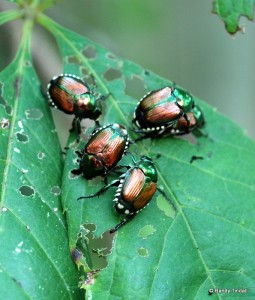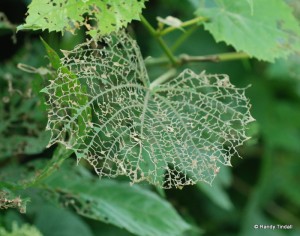Koganemushi froze, senses alert for danger as it detected motion. It raised its tiny oars in defense, then tucked and rolled, releasing its devastated leaf in a desperate bid to disappear beyond my sight. Too late. Before it could turn its free fall into flight, it hit the soapy water in my jar and floundered. Maybe it chittered out the coleopteran equivalent of “Uh-oh”, or maybe not, but it would not bother the wild grapes in our backyard again.
It was a handsome creature, beautiful even, and neither Nadia nor I took any pleasure in sending it and its many, many glittering friends to a soapy demise, but we took even less pleasure at the sight of the tattered and shredded leaves the Japanese Beetles were leaving in their wakes. The grape, pawpaw, and virginia creeper foliage visited by Popilia japonica had been “skeletonized”—about as accurate a descriptor as one could ask for.
We were determined to defend our domain.
It’s all rather sad, really. These pretty beetles (Koganemushi means “gold beetle”, I hear) never wanted to be here in the first place, in all likelihood. They apparently showed up in the early part of the last century in New Jersey, having been trapped in a shipment of iris bulbs, and immediately went about doing what we all do when faced with trying circumstances. Surviving. It seems they have done quite well, having tumbled into a land of milk and honey and few predators.
Like us, they appear to be generalists, which is a time-tested strategy for getting by where fussier types would fall by the wayside. No pawpaw around? That rose over there looks might tasty. No roses? Let’s check out the beans! Or the irises! Or the….well, you get the picture. For all I know, if they went clean through all the greenery, they might take on the squirrels next.
It’s an old, old story, one that has been, and still is, enacted by many species, including one that drifted out of Africa once upon a time, spread and adapted, devoured pretty much everything in its path, and sauntered across a newly-exposed land bridge that led eventually to our backyard. Many of these odd-gaited creatures met the equivalent of a jar of soapy water along the way, generally wielded most lethally by their own brethren objecting to being pushed around by anyone, regardless of appearance. But the rule in the natural world, then and now, seems to be: Invading is easier than getting rid of invaders.
But it may be possible to come to an accommodation. Nadia and I pick the beetles off by hand, but there are other methods available. One is using Paenibacillus popilliae spores in your yard to give the beetle larvae Milky Spore disease. We have no experience with it and I hear it takes time, but apparently it can be quite successful. Let me know. There are various chemical sprays and powders that are supposedly effective, but we’re just not that riled, yet.
You could also try strategy, like convincing your neighbors that those nifty pheromone traps are the greatest thing since bipedalism helped us get here. This should pull most of the beetles out of your yard and into theirs. Remember to keep congratulating the neighbors on all the dead beetles in their bags so you can string this out as long as you can. I did run into one neighbor who used the traps to decoy the critters away from her roses into another part of her yard, and she claimed it worked. Along these lines you might also experiment with planting beetle fodder that you don’t care about to draw the insects away from plants you really are partial to. Seems in our backyard that they prefer grapes to almost everything else. This also helps concentrate them and make them easier to grab. Watch what they go for in your yard and if you’re lucky enough that their favorite is not your favorite, use that to keep ’em distracted.
At least one attempt seems to have been made to bring in the mercenaries—old enemies from Japan in the form of parasitoid Tachinid flies that are host-specific. This is a risky road to walk. Specificity is a good trait in imported biological controls, even if it’s not so good for their survival in a strange land. You want these things to go away when their work is done, but nature sometimes has ways of doing end runs around a sure thing. Personally, I wouldn’t have brought them in, but nobody asked me at the time and they’re here now.
There is lots of information out there, and where there is knowledge, there is hope. Let us flail away, but in the process it really is okay to sneak an admiring glance or two at how handsome these beetles actually are.
And remember—defend your turf with a kind heart. After all, these little golden samurai aren’t doing anything we haven’t done.


